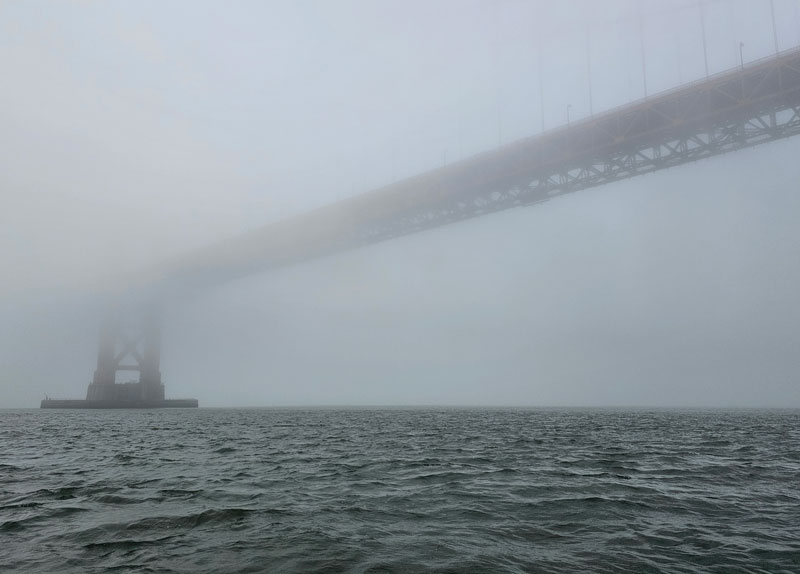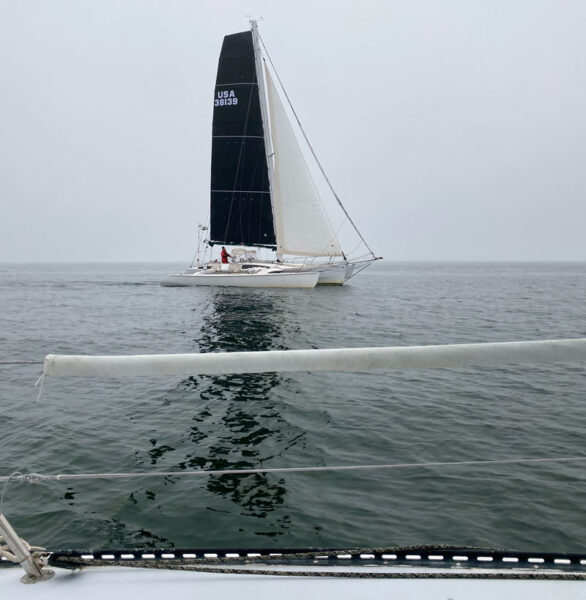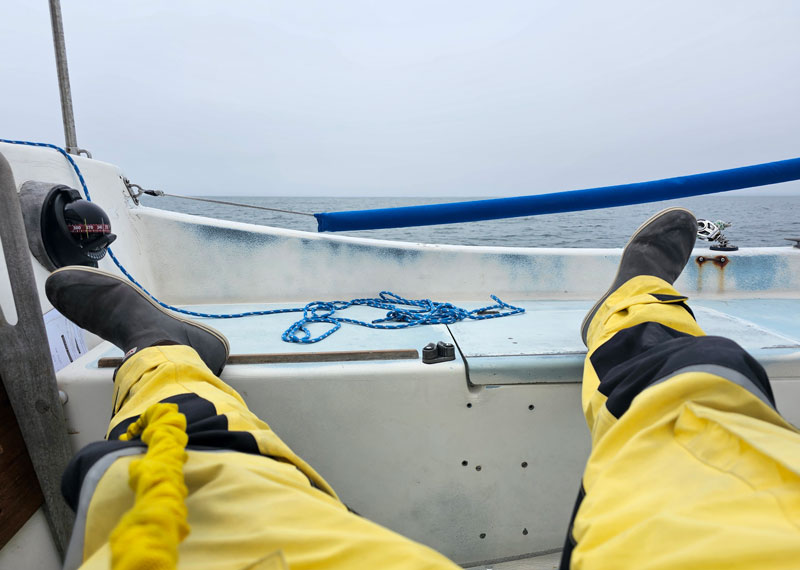
SSS Singlehanded Farallones Race: Foggy, Unfinishable
On May 11, the Singlehanded Sailing Society’s Singlehanded Farallones race had most of the ingredients for a great day: a classic course out the Gate, a good ebb at the start to help boats get under the bridge, a 16-hour time limit, and a good flood before the midnight cutoff to help boats get back. Missing were visibility in the heavy fog, and wind. Fourteen boats started. No boats finished, with the most persevering only getting back in the Gate around 11 p.m.
Sean Mulvhill of the J/120 Jamani said, “It was an unusual Farallones race Saturday, with 12 knots of southwest wind getting out of the Bay, dense fog, and progressively lighter wind out to the Lightship.The expected building northwest wind did not make an appearance. Jamani retired at 2:30, leading the pack but still 12 miles from the SE Farallon mark. The dense fog in the Bay and out beyond Mile Rock made navigation by GPS and attention to nearby vessels by AIS crucial. Despite the gloomy weather, it was a good day on the water.”

The morning started with heavy fog coming in, especially on the north side of the Central Bay. The Coast Guard reported visibility of a quarter mile in the Bay, and one tenth of a mile outside. Asked about the tenth-mile visibility, Sean Mulvhill reported, “Yes, or even less at Mile Rock. Much better at the Lightship and beyond. Glassy water and light winds beyond the Lightship.” Greg Nelsen, skipper of the Azurra 310 Outsider, retired with the message: “No issue, just no visibility past the bow until back near Bonita.”

Truls Myklebust of the Explorer 44 trimaran Caliente said, “We had a decent breeze to start, to get us out past Point Bonita. Then we had a really light stretch in dense fog around the ship channel. Several boats turned back there. However, we eventually got some breeze, and had a very pleasant sail out past Duxbury Reef with Greyhound, Jamani and Werewolf after the dense fog had lifted. However, that breeze eventually died out. The forecast afternoon breeze never filled in, so it eventually became clear that we wouldn’t be able to make it around the island and back in time.”

The farthest-west boats were at most a mile or two past the northern approach buoy when they turned around.
As often happens when it is light on the ocean, it was gusty when the retiring boats re-entered the Bay. Evan McDonald of the F-22 trimaran Greyhound said, “It went from low wind to solid 24 gusting to 28 in the Slot.”
This was the first race where the SSS required all boats to have AIS transponders. Effective 2024, the SSS board determined that, consistent with the YRA’s requirements for offshore races and US Sailing and other bodies’ requirements for coastal races, SSS would require AIS transponders for its coastal and ocean races. This includes the next SSS Singlehanded Transpacific race to Hawaii, scheduled for June 2025.
“After the heavy fog at last year’s Singlehanded Farallones, the SSS board took a hard look at an AIS requirement,” said the race committee. “Given the SSS’s emphasis on safety, seamanship and independence, which includes an eye on frugality, this was not an easy decision. The board’s cost/benefit analysis resulted in strong feedback from our fiercely independent group of serious sailors.”
Truls Myklebust on Caliente said, “We had an AIS incident even before the race started. One of the boats was on the way to the start line in heavy fog, and crossed the deep-water shipping lane in front of an outgoing container ship. AIS made the boat visible to the ship, and the Coast Guard tried to hail her on VHF 16. I recognized the boat name, and hearing no response, suggested they try the race channel instead. They were able to reach the boat and avoid a collision.”
In the first 90 minutes of the race, two container ships and two Coast Guard cutters hailed or phoned the race committee in the foggy conditions. The second cutter hailed, “Flotilla leader, where are your vessels?” AIS provided the race committee with an answer, reducing stress and risk for all involved.
As the race ended in the dark, a tug moving 10 knots through the Gate used AIS to detect an inbound racer proceeding at 5 knots in the outbound lane. The tug hailed VTS for permission to divert to the inbound lane and talked to the inbound vessel, making for a professionally handled non-event.

Readers — The decision by the YRA and SSS to require AIS transmitters for offshore races has been controversial, mostly due to the expense and hassle of purchase and installation. We invite comments on this topic, but please keep them polite and constructive (note that comments in ‘Lectronic Latitude must be approved by our editors before they appear to readers).
I remember when PFDs were controversial too, people didn’t want to wear them. Now it’s the norm.
The YRA/SSS AIS requirement looked simple. But as it turned out, not. First we discovered NANCY’s old VHF antenna and cable were shot and needed replacement. The SWR was horrible! That required a visit to Spauldings and a trip to the masthead via crane and bosun’s chair to install the new antenna and cable. I credit that as a plus since the old stuff was probably original and the new SWR is perfect. Even though I’m a HAM I never checked the SWR previously; just “Radio Check Please.” with a quick “Okay” reply from a nearby boat Then issues integrating the Garmin AIS into the existing system. It wasn’t plug and play! We still need to power up the B&G instruments before turning on the Garmin AIS to avoid problems. But I am convinced it was worth it. I didn’t sail the SSS Farallones, but we can “see” marine traffic clearly with all the important information on the screen. I’m looking forward to using the AIS on the ocean beginning with the YRA DuxShip. It’s another layer of safety out there.
An AIS transponder is much much cheaper then a new #3… and costs about the same as three inflatable lifejackets. Maybe $750 with an integral “antenna splitter”. Dramatically increases awareness of ships (and other entrants)… its value as an important safety device is indisputable. Sure a bit of work to install… but not much more/different then installing a VHF radio (I look forward to the day a single device “does it all”… VHF+AIS Transponder at a “reasonable price ).
Net net… not cheap… but its worth the investment.
Now there are a few other safety related equipment requirements they are not cheap and are of questionable safety value… but that is for another day/discussion… 😉
I’m puzzled. Sailboats are a lot more maneuverable than container ships, so shouldn’t those under sail keep a lookout (electronically, if there is no visibility) for them rather than vice-versa?
For us Race Committee types- especially for the Offshore races like Half Moon Bay, or ( the one I do ) the Drakes Bay Race, it is HUGELY helpful to have AIS for all racers offshore- especially when you drop out and DON”T NOTIFY THE RC ! At least we can see your approach to the finish line, or your dramatic course change for home as the case may be. I applaud Jim Quanci’s comparison of the pricing !
As a racer I wholeheartedly support the decision for AIS. THANK YOU YRA for making racing safe.
I feel much safer knowing the big ships can see me via AIS in the fog, and I can see them. My Raymarine AIS uses minimal power, and I installed a dedicated ais antenna off the pulpit no problems.